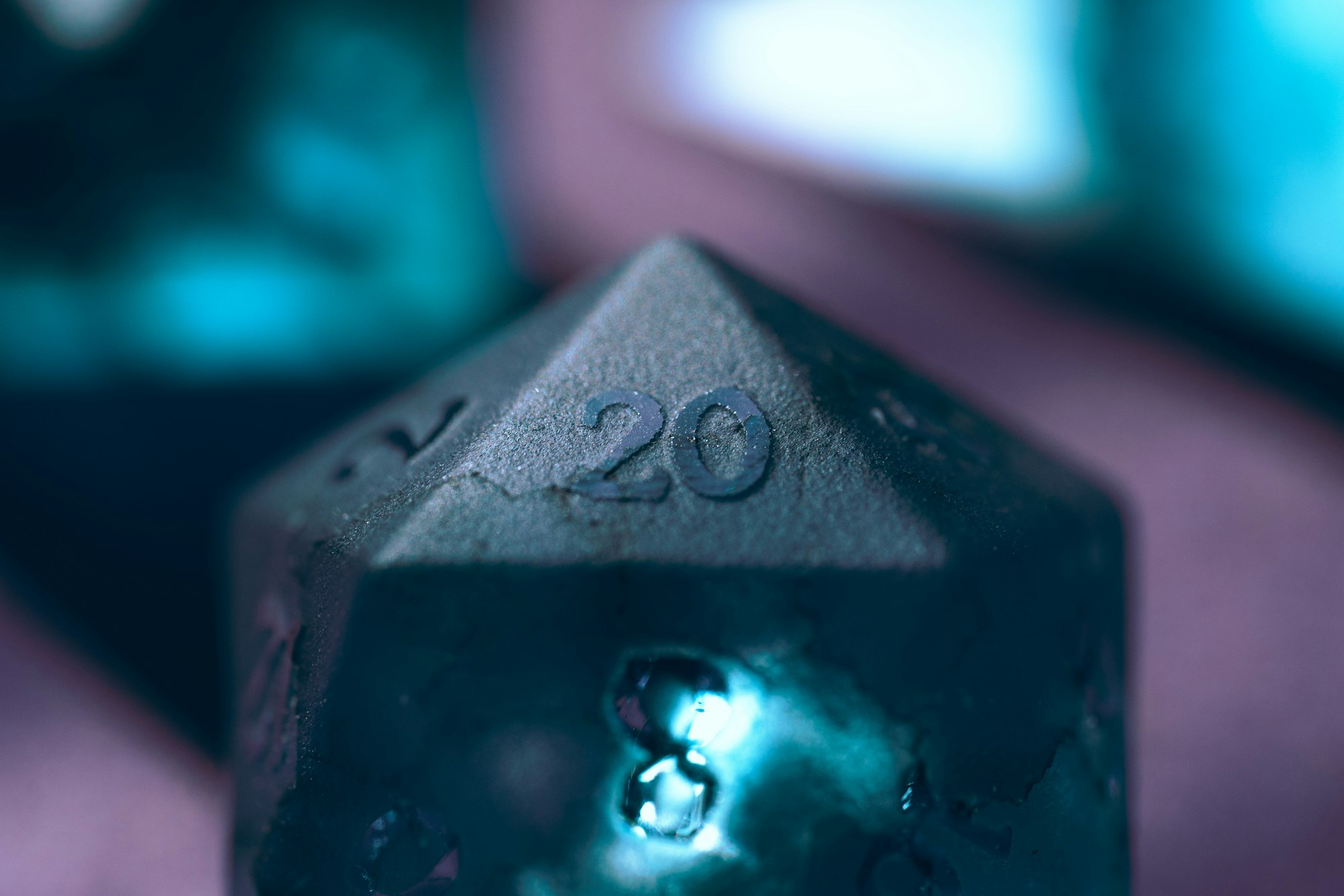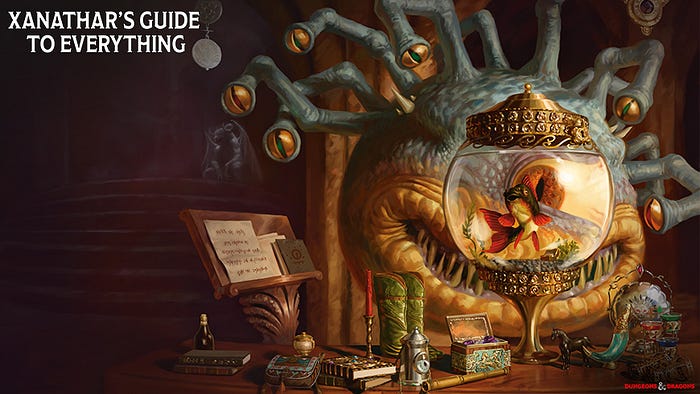Breaking Down the Dungeons & Dragons Character Sheet - Part 6
Explaining your inventory and how to use it.

When you’ve got your character built, it’s time to stack them with gear. That’s right; today, we’re talking about inventory!
Building, reading, and managing your inventory is an important skill that can keep your character from ending up the creek without a paddle — or in a fight without their sword, or in a dungeon without a lockpick, or…
Well, you get the point. Here’s what you need to know about inventory systems in Dungeons and Dragons.
Why Inventory Matters
You never really know what’s going to come in handy when you’re out on a mission to save the world.
That ring you found in the goblin bandit camp in session two? It might be an invisibility ring that gets you out of a really tight spot later. That letter the Duke of Wherever gave you for driving out that banshee? Yeah, it gets you into the town where the big bad has taken up residence — without alerting all the guards. And that’s not even mentioning all the gold you’re racking up.
Items play a huge role in D&D in that they do the things that you can’t otherwise do. They add a lot of flavor to the roleplay and give you a huge mechanical advantage, especially if you’re not a caster. Potion of Fireball, anyone?

Where Your Inventory Comes From
Your inventory is, to put it simply, all of the things your character is lugging around with them on an adventure. It can come from a variety of places, which can be compressed into three categories.
Starting Gear
Your starting gear is the set of items you have on you when you begin your adventure. These items come from your class and background and usually include a set of armor, a weapon, some travel supplies (rations, a tent, extra clothes, etc.), and some items specific to your character’s abilities.
These specific items are your packs — sets designed to help you with scenarios your character might get into. There’s an explorer’s pack filled with torches and rope, a dungeoneer’s pack with pitons and other climbing equipment, a burglar's pack filled with distractions and lockpicking tools; the possibilities are endless.
Loot
Doesn’t everyone want to enjoy the spoils of war and/or the utter annihilation of a group of enemies way below your level? Loot consists of all of the items gathered over the course of your adventure. It might come from defeating enemies, exploring ruins, or being gifted by those you’ve done a good turn for.
Loot generally consists of money and magic items. Sometimes these items are pre-set in the adventure — meaning you’re all going to get them, and you all get the same amount — and sometimes they’re given out at the discretion of the DM.
Shopping
Just like in the real world, most towns in D&D will have some kind of shopping available to you. They may have entire merchant quarters, or there may just be a cart or two you pass on the road. Whatever you encounter, you’re going to want to look through the wares.
D&D uses its own monetary system based on gold pieces. We’ll talk more about that in a bit, but for now, it suffices to say that it pays to ask your DM how they’re converting money. Slapping a platinum down in a silver economy is going to get you stared at…or robbed.
How to Read Your Items
Like anything else in this game, every item in your inventory has stats associated with it. Those stats are:
- Type. What is this item? Is it armor, gear, clothing, or something else?
- Count. How many of these items do you have?
- Cost. How much is this item worth in terms of gold, silver, or copper pieces?
- Weight. How much does it weigh in pounds?
- Damage. If it’s a weapon, how much damage does it do, and what kind?
There’s also a “notes” section of the item that lists what kind of item it is in more detail.
- Utility items are useful, everyday items like candles and bedrolls.
- Social items are items that you can use during social events like incense and fancy clothes.
- Containers are boxes, trunks, backpacks, etc.
- Combat items are, well, items you can use in combat, like weapons and shields.
- Magic items are items infused with some kind of magical property.
- Cursed items are magic items that have bad effects associated with them.
You can read all of this in your Inventory tab or box. Each item gets its own line with a section for quantity, cost, weight, damage, and notes. Your currency goes in a separate little box so that you can keep track of it.
Let’s look at an example.

This is the first page of the inventory of Wheeze Wallwalker, my Air Genasi Rogue. I keep his sheet on DndBeyond for my own sanity; I’m terrible at paperwork. Because of this, I get a neatly organized Inventory tab, where I can sort by where I’m keeping the item, as well as whether or not I’m attuned to it (more on that in a minute).
Let’s look at that top item. Wheeze, being a long-range fighter, has Arrows. These are listed as Gear, with the subcategory of Ammunition, meaning they can be fired. They’re about a pound in weight (for all the arrows combined), and he's got 20 of them. They cost him 1 gold piece collectively. They do damage (it differs depending on the bow used) and are a combat item.
Knowing all of this information helps you determine how close to your maximum carrying capacity you are, letting you avoid the penalties that come with going over it (this is called encumbrance, we’ll talk about that in a second). It also lets you know how much money you have, what you can afford to sell or use, and when you need to restock. Understanding what your items are and how they function in the game can help you to use them with confidence.
Attunement and Curses
Now, because it’s D&D, items can’t be as simple as magic and not-magic. Nope, there’s another subsystem you need to be aware of, personal effects. By this, I mean that some items in D&D have special effects on the people who possess them, which can be both positive and negative.
Usually, if a magic item has particularly cool personal effects, it’ll require attunement. Attunement is the process by which your character grows connected in some way to the item they have, usually through sufficient study or training with it. Some items can be attuned to in an hour or so, some take several days or weeks of study, and some you can attune to the second you touch them. You can have up to three items attuned to you at the same time. If you want more than that, you’ll have to switch something out.
Curses, on the other hand, are basically evil attunement. An item will latch onto its owner and produce some bad effect on them. These curses can be simple and mundane — causing you to summon random animals from a bag or produce goo of some description. They can also be devastating — siphoning health from the owner or causing them to lose their minds slowly. Cursed items usually require strong magic to get rid of; in fact, there’s a spell that’s specially designed for this: Remove Curse.
Coins and Currency
As with nearly any other world, the worlds of D&D have their own currency systems. For the sake of mechanical ease, most worlds operate off of the same system. In it, there are five kinds of coins: copper, silver, electrum, gold, and platinum. Here’s how they divvy out:
- One platinum piece is worth 10 gold pieces.
- One gold piece is worth 10 silver pieces.
- One silver piece is worth 10 copper pieces.
- One electrum is worth 50 coppers, or 5 silvers.
Most worlds work off of the gold price, meaning that shops will tell you how much gold something is worth. Anything that costs less than one gold is pretty cheap and anything that costs any amount of platinum is pretty expensive.
I’m going to be so real, almost no one uses electrum (so much so that I had to go back and look to see how it’s spelled and where it is in the order). They’re a somewhat weird middle coin that doesn’t really make sense to use in most societies, so most DMs elect to ignore it.
That being said, always check in with your DM to see how the monetary system works. They may choose to operate on a different exchange rate or operate with the silver price of things, or they may have a completely different system altogether. Knowing the money system is important — otherwise, you and your party might just break the local economy, or become a massive target for thieves and bandits.
Encumbrance
So, one thing that a lot of people forget when it comes to inventory in D&D: physical things weigh stuff.
That might sound kind of stupid, but bear with me; when you’re out and about, what do you normally carry with you? A purse, a backpack, maybe a briefcase? Maybe you’re going on a trip, so you have a suitcase and a carry-on. Altogether, most people are only lugging around between 10 pounds and, at most, about 60 pounds.
An adventurer’s full kit includes things like a full set of metal armor, climbing gear like pitons and rope, rations for several days at a time, waterskins filled to the brim, books of lore and magic, hulking great weapons (multiple!), and more. If you really think about it, would you be able to carry all of that with you, for months on end, on the road, while fighting? Probably not, unless you’re in the military. In which case, you count as an adventurer — I’m sorry, I don’t make the rules, you just do.
For the sake of the game, the weight of your gear is tracked in pounds; it’s a ballpark range and not always entirely accurate (I wouldn’t say that ten feather quills weigh a whole pound, but what do I know?), but it’s good enough to work with. How many pounds you can carry on you at a time is called your carrying capacity. The standard for carrying capacity is five times your Strength score. So, a character with a Strength of 10 can comfortably carry only 50 pounds at a time, while a character like my Aasimar Fighter, Gatriel, with a Strength of 29, can carry a whopping 145 pounds with no problem.
Going over your carrying capacity leads to something called Encumbrance. When your character is encumbered, their speed drops by 10 feet of movement and they’re struggling. When they’re carrying twice as much as they should, they’re considered heavily encumbered, and their speed drops by 20 feet of movement.
Most DMs will be extremely lenient when it comes to encumbrance; some choose to ignore it completely. Some, however, like the challenge presented by limiting the amount of loot you can comfortably bring with you. Check with your DM to see what their stance is, and, if they choose to track it, make sure you’re keeping an eye on the total weight of your inventory.
Up Next — Marvelous Miscellany!
And just like that, the penultimate piece of this multi-part series is done! Your inventory matters, even when you’re not thinking about it. It’s a good idea to make yourself familiar with the items you can get and the items you have; you never know when a hidden ability will save your life.
In the final part of this series, we’re going to cover all the little things I haven’t talked about yet, from languages to tools to armor and more. I’ll offer you a few of my favorite character-building tips, and then, you’ll be off to face the table on your own. I think you’re going to be ready.
